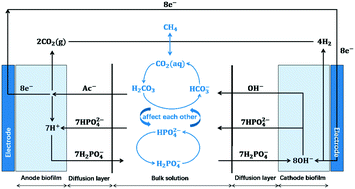Modelling of a CH4-producing microbial electrosynthesis system for energy recovery and wastewater treatment†
Abstract
Microbial electrosynthesis systems (MESs) is a novel device for waste degradation and energy recovery. Using mathematical models to investigate its physical, chemical, and biological processes is an effective approach to understand waste removal and bioenergy production in an MES. However, almost all of the present models have assumed an unchanged pH during MES operation, leading to imprecise analysis for waste removal and bioenergy production, which are the critical indexes of MES performance. This work develops a mathematical model to investigate pH variation and its influence on MES performance. Herein, we show that CO2 produced by substrate utilization and the pH buffer added initially can work together through equilibrium reaction to result in the variation of pH, and further lead to the change of microbial activity. These variations result in the change of MES performance in the terms of current density, substrate removal rate, and CH4 (a typical product) production rate. The further analysis shows that substrate concentration, pH buffer concentration, and electrode distance are important parameters to achieve a high performance of MESs. Our results provide the underlying insights needed to guide the design and operation of MESs.



 Please wait while we load your content...
Please wait while we load your content...